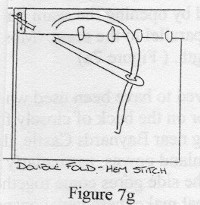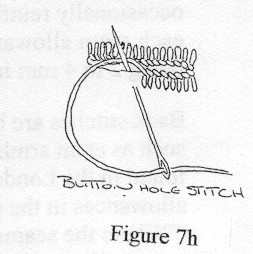Section # 1 Stitches Used (primarily from Crowfoot et al)
 Most
of the construction stitches found appear to be running stitches of various
types (as opposed to back stitches). Major seams were sewn with a simple
running stitch, occasionally reinforced by opening the seam flat, and
placing another row of stitches on each seam allowance, parallel to the
seam. Most of the stitches found were quite small, being 2 to 4 mm in
length. ( Figure 7a)
Most
of the construction stitches found appear to be running stitches of various
types (as opposed to back stitches). Major seams were sewn with a simple
running stitch, occasionally reinforced by opening the seam flat, and
placing another row of stitches on each seam allowance, parallel to the
seam. Most of the stitches found were quite small, being 2 to 4 mm in
length. ( Figure 7a)
 Back
stitches are believed to have been used when seams came under pressure
or stress, such as at an armhole or on the back of closely fitted hose.
Although no examples were found in the London dig near Baynards Castle,
they are used to hold down seam allowances in the Greenland gowns, particularly
in stressed areas such as bodice seams. ("Where the seams of the side
gores come together at the waist they are ornamented with a row of backstitches
that make them very conspicuous." Norlund, p 108 referring to gown # 41)
(Figure 7b)
Back
stitches are believed to have been used when seams came under pressure
or stress, such as at an armhole or on the back of closely fitted hose.
Although no examples were found in the London dig near Baynards Castle,
they are used to hold down seam allowances in the Greenland gowns, particularly
in stressed areas such as bodice seams. ("Where the seams of the side
gores come together at the waist they are ornamented with a row of backstitches
that make them very conspicuous." Norlund, p 108 referring to gown # 41)
(Figure 7b)
 The
fabrics discovered in London, England are mainly felted wool. Felted wool
does not fray as readily as other fibers, therefore little seam finishing
was required. The reinforced running stitch would give some protection
against the little fraying that occurs in these fabrics. (Figure 7c)
The
fabrics discovered in London, England are mainly felted wool. Felted wool
does not fray as readily as other fibers, therefore little seam finishing
was required. The reinforced running stitch would give some protection
against the little fraying that occurs in these fabrics. (Figure 7c)
 On
fabrics that fray (such as linen or loosely woven wool), seams need more
protection than these stitches alone can give them. Some of the garments
in London were lined with silk or wool, for comfort and protection of
the seams. Norlund mentions "overcastting" repeatedly, but gives no diagrams
indicating what he means by this. There are a number of modern stitches
that can be considered 'overcast stitch', so until I can see a picture
of the seam, I guess you could use your favourite!
On
fabrics that fray (such as linen or loosely woven wool), seams need more
protection than these stitches alone can give them. Some of the garments
in London were lined with silk or wool, for comfort and protection of
the seams. Norlund mentions "overcastting" repeatedly, but gives no diagrams
indicating what he means by this. There are a number of modern stitches
that can be considered 'overcast stitch', so until I can see a picture
of the seam, I guess you could use your favourite!
 In
the modern world, a method called French seaming encloses the raw edges
of the seam by sewing each seam twice: the first time wrong sides together,
pressing, then sewing the second time right sides together around the
seam
In
the modern world, a method called French seaming encloses the raw edges
of the seam by sewing each seam twice: the first time wrong sides together,
pressing, then sewing the second time right sides together around the
seam  allowances
of the first. If the seam allowances are small (5 to 8 mm) on each pass,
the result is quite discreet. While this exact technique has not been
found in Greenland or London, something very similar is pictured in Inga
Hagg's book on the finds at Hedeby. In this version the seam is sewn with
the regular seam allowance (10-16 mm). Then the raw edges are folded in
towards each other and the folds on top are whip stitched together . This
results in something that looks very like a modern French seam. (figure
7d)
allowances
of the first. If the seam allowances are small (5 to 8 mm) on each pass,
the result is quite discreet. While this exact technique has not been
found in Greenland or London, something very similar is pictured in Inga
Hagg's book on the finds at Hedeby. In this version the seam is sewn with
the regular seam allowance (10-16 mm). Then the raw edges are folded in
towards each other and the folds on top are whip stitched together . This
results in something that looks very like a modern French seam. (figure
7d)
 Hem
stitch was used for holding down the edges of facings as well as for the
obvious. Hems were also put up using a running stitch. Single folded hems
were the norm amongst wool garments, while silk fabrics were folded twice,
due to their tendency to fray. (figures 7 e-g)
Hem
stitch was used for holding down the edges of facings as well as for the
obvious. Hems were also put up using a running stitch. Single folded hems
were the norm amongst wool garments, while silk fabrics were folded twice,
due to their tendency to fray. (figures 7 e-g)
Hem stitch was used for holding down the edges of facings  as
well as for the obvious. Hems were also put up using a running stitch.
Single folded hems were the norm amongst wool garments, while silk fabrics
were folded twice, due to their tendency to fray. (figures 7e-g)
as
well as for the obvious. Hems were also put up using a running stitch.
Single folded hems were the norm amongst wool garments, while silk fabrics
were folded twice, due to their tendency to fray. (figures 7e-g)
Button holes were worked in buttonhole stitch. Stitch width was 1 to
1.5 mm . Distance between stitches was about .5 mm. The overall length
of the hole varied from 7 to 10 mm to 12 to 14 mm. The button holes found
in London were straight (not keyhole shaped) and did not feature "bar
tacks" or reinforcing cord under the stitches as many modern hand made
button holes do. Period button holes are worked quite close to the garment
edge, (only about 8 mm away) in contrast to modern ones which are frequently
16 to 25 mm away from the finished edge. (figure 7h)
Next >